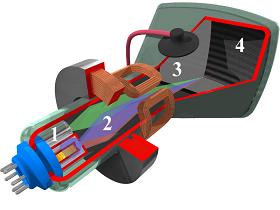In a colour television, represented schematically in the picture, there are three different emitters (1) which create electron beams of different energies (2). There is a complex system of magnetic fields (3) which focuses the beams on the screen (4), where there are three different substances per dot which are sensitive to each of the beams. Each of these substances emits light of a different colour (red, green and blue, the primary colours in the RGB system) with an intensity that depends on the intensity of the corresponding electron beam. |

|
